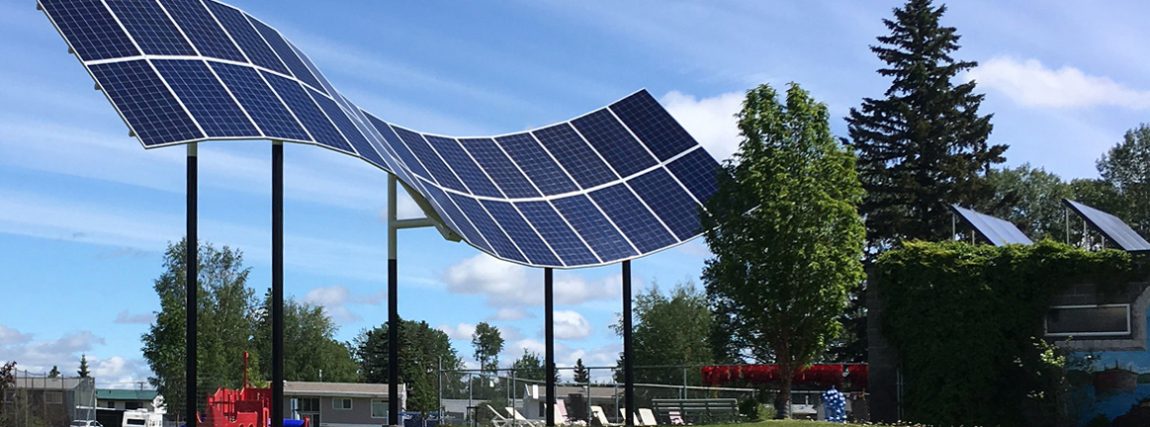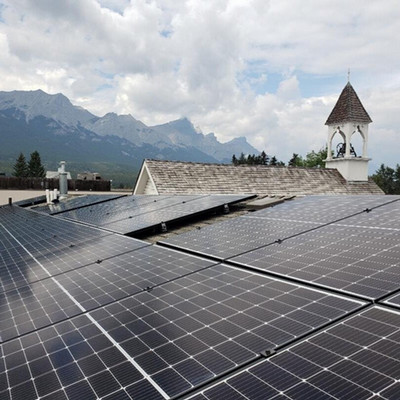Co-operatively Owned Green Energy Companies
Clark Banack, Director, Alberta Centre for Sustainable Rural Communities - 3 April 2024

102kW SOLAR WAVE, Hudson's Hope outdoor swimming pool facility. Photo: Ron Moch for Peace Energy Co-op
There is now no doubt that the world is experiencing a rapid energy transition. Alberta is at the forefront of this transition in Canada, accounting for over 75% of all wind and solar energy projects built in 2022, and more than 92% of Canada’s overall growth in renewable energy and energy-storage capacity in 2023! This is largely due to our deregulated energy system and the natural abundance of both sunshine and wind. This pattern of tremendous growth represents a key pillar of Alberta’s economic development potential going forward, with rural areas in particular very well-situated to take advantage of these trends. But how do we ensure that rural communities and rural citizens truly benefit from this industry growth? One of the surest ways is to encourage and incentivize co-operatively-owned green energy companies. We encountered two great examples of this over the course of this project, both of whom utilize the community-investment mechanisms at the heart of Opportunity Development Co-ops.
In 2003, Peace Energy Cooperative became the first Renewable Energy Co-op incorporated in Western Canada, with the goal of developing a large wind farm near Dawson Creek, British Columbia. As capital requirements increased, the co-op eventually partnered with private entities to ensure the building of British Columbia's first commercial wind facility, a 34-turbine, 102mw solar farm capable of powering roughly 35 000 homes. The co-op has since developed a robust residential, commercial, and on-farm installation division operating in the Dawson Creek area, activities that added a second revenue stream to the co-op and have allowed for the hiring of 2 full-time paid employees and 3 or 4 regularly paid contractors that help with marketing, installation, etc. Peace Energy has now completed multiple installations totalling over one megawatt of combined solar installed in the Peace Regions of Alberta and British Columbia.
The most ambitious project undertaken by the co-op, however, is their current work toward developing an $11 million, 4.99 megawatt solar farm comprised of roughly 12 000 solar panels on a section of land located near Peace River, Alberta. In 2021, a lease was secured on the proposed solar farm site and the co-op subsequently raised substantial capital from local members, conducted the required (and rather expensive) engineering and regulatory studies across 2022/23, conducted significant community engagement, and devised plans for the a solar farm that would implement best practices related to agrivoltaics (essentially a commitment to use land simultaneously for solar panels and agriculture) and biodiversity stewardship on the solar farm site. Unfortunately, despite meticulously preparing their application for development approval for the Alberta Utilities Commission, the co-op was blindsided by the Alberta Government’s unexpected decision to have the Alberta Utilities Commission institute a six-month moratorium on approving all wind and solar power projects greater than one megawatt in 2023. However, with the moratorium now lifted, the Peace River Energy Project will represent a significant achievement for Peace Energy Co-op, a formidable boon for the surrounding rural areas, and an inspiring example of what is possible via the co-operative model embraced by Peace Energy. Construction of the solar farm, it is estimated, will create roughly 50 jobs over an 8-month period, followed by 3-5 full time permanent jobs going forward for the 25-life span of the project. This is in addition to the investment gains that will be returned to the wide range of community investors who co-operatively own this project, rather than distant shareholders.
Bow Valley Green Energy Cooperative, located in Canmore, also utilizes the same community-investment model as Peace Energy. However, they have embraced a micro generation, "behind-the metre” model that involves multiple small-scale solar installations across several commercial sites in the Bow Valley, rather than the construction of a large single solar farm. In essence, Bow Valley Green Energy Cooperative installs a solar array on the roof of a willing commercial “host” (at the co-ops expense), then sells the power generated by the installation to the commercial building owner. As part of this process, a 25-year power purchase agreement is negotiated between the co-op and the building owner which ensures the latter a stable long-term price for their electricity, while the co-op receives an ongoing revenue stream that allows them to fund further projects and return a modest profit to its investors.

Having established a financially viable business model within the existing provincial regulations, Bow Valley Green Energy Cooperative signed their first power purchase agreement with the Ralph Connor Memorial United Church in Canmore in 2021, raised the required capital in the community, and installed a 11.25 kw solar array. This was followed by a 127 kw system installed on a newly constructed mixed-use condo and retail complex in Canmore in the Fall of 2022. In 2023 the co-op successfully installed two more solar arrays: a 26kw system on Tempe B’nai Tikvah in Calgary and a massive 291 kw system on a magnesium oxide processing factory outside of Canmore, two projects, noted the president of Bow Valley Green Energy Cooperative, that take the co-op closer to their rather impressive target of 1 Megawatt of installed renewable energy capacity by the end of 2025.
Both Peace Energy Cooperative and Bow Valley Green Energy Cooperative have faced plenty of challenges on their respective paths. Still, like Opportunity Development Co-ops more generally, we see significant potential for rural communities across Alberta in the innovative use of the co-op models employed by both the Peace Energy Cooperative and Bow Valley Green Energy Cooperative. What the two models offer are unique opportunities for ordinary people to become key players in the energy transition, ensuring both the control and the profits generated by solar energy generation remain in local communities rather than the pockets of corporate executives and distant shareholders. In addition, both co-ops have also been successful in creating good local jobs in their regions given the local solar installation they have been encouraging.
To learn more about Green Energy Co-ops, and the opportunities and challenges they face, check out the Alberta Centre for Sustainable Rural Communities' Final Report on Co-operatives and Rural Economic Development HERE.